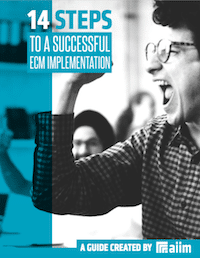The AIIM Blog
Keep your finger on the pulse of Intelligent Information Management with industry news, trends, and best practices.
Content Migration | Document Management | Intelligent Information Management (IIM)
When planning M&A integrations, teams focus intensively on migrating financial systems and customer databases. But there's a critical blind spot: the unstructured data—emails, documents, and files—that often contains the most valuable knowledge assets and justifies the acquisition in the first place. This oversight doesn't just leave value on the table; it creates hidden risks and operational chaos that can undermine the deal's success.
Share
Content Migration | Digital Transformation | Intelligent Information Management (IIM)
Research Indicates Digital Transformation Has Stalled After we received the survey responses for the AIIM 2023 State of the Intelligent Information Management Industry Report, I spoke to the report’s authors, Dave Jones and Theresa Resek, about a concerning statistic. Enterprise digital transformation (DT) efforts have stalled. Dave later wrote in the report “over 65% of organizations have achieved significant successes with DT, but that still leaves at least a third who have not.”
Share

Making an ECM implementation successful requires planning and attention to detail. The best way to create the right solution is to identify organizational goals and priorities. Learn how to manage a successful implementation in our free guide.
The amount of data organizations must manage today is truly mind-boggling. Research shows that there are 2.5 quintillion bytes of data created each and every day. During the last two years alone 90% of the data in the world was generated. It’s no wonder that many organizations struggle to simply keep pace. And moving mountains of data from older legacy systems to modern cloud-based repositories can seem out of reach for most, regardless of the potential advantages of modernization. But what can you do when you need to migrate? If leaving your data in place is not an option, and moving it makes you lose sleep at night, you can quickly feel overwhelmed by the chaos. Thankfully, there are some new approaches to data migration that may provide an answer. Which is the best approach for your project? Let's take a look at three common approaches to migration to compare them.
Share
Migrating to a new system or moving to a new platform? Then you’ll definitely need to create a successful data migration strategy to protect your valuable data and achieve the desired results. In this article, we’ll take a look at several ways to migrate your data. They will allow you to build a successful strategy, prevent data loss, and make everything as efficient as possible.
Share
Content Migration | Electronic Records Management (ERM)
Information has transformed in a big way over the past few decades, with some of the most significant changes coming in just the last five years. Year over year, information has seen a dramatic increase in both value and volume. The advancement of new technology has transitioned much of this from paper to digital – which presents its own set of new challenges regarding compliance, access, and protection. These changes all add up and have had a profound impact on how we create, manage, store, and access information today. Here at AIIM, we see this as an opportunity. We believe this means the practice of managing information and records can no longer be seen as solely an exercise for compliance – it needs to go beyond compliance and a key component in your business strategy.
Share
The international standard on records management, ISO 15489 defines migration as the: "Act of moving records from one system to another, while maintaining the records' authenticity, integrity, reliability, and usability." But, migration is much broader than just records. Essentially, any time a legacy system is decommissioned, it should be reviewed to determine: What information is stored there? Does this information still need to be actively accessible?
Share